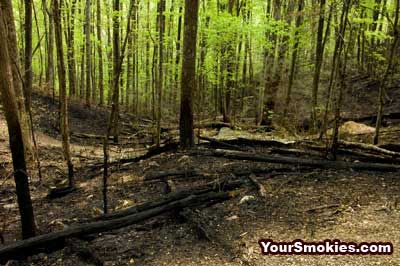Thanks to Discover Life in America (DLIA), Kris Johnson Great Smoky Mountains national park vegetation management specialist and Margie Hunter author of Landscaping with the Native Plants of Tennessee, International Biodiversity Day in the GSMNP at the Twin Creek Science Center was incredibly informative and thought provoking.
Any talk given by Kris Johnson is a home run and this one was no exception. The work that she and others working for the Great Smoky Mountains must go through in order to keep invasive exotic plants under control is staggering.

Part of the job of the national park service is to maintain the historical integrity of national park and beside the preservation of man made objects such as buildings, monuments and other historical and cultural artifacts as well as the flora and fauna of an area.
Non-native invasive plant species reek havoc on an ecosystem by crowding out native plants, raising the risk and intensity of wildfires, changing the hydrological makeup of an area, diminishing food sources for local plants and animals, creating a toxic environment for other plants and animals, and creating financial hardship through excessive maintenance issues.
While there are a few ways we can all help reduce the numbers of invasive non native plants species that threaten the biodiversity and the ecosystem of the Great Smoky Mountains national park, one of the easiest way to protect our environment is to only use native species in our own landscaping and gardens.
Native Plant Alternatives to Invasive Exotic Plants in Tennessee compiled by Margie Hunter
Trees:
Invasive Exotic Species: Mimosa (Albiziajulibrissin)
Native Species Alternative: Chionanthus virginicus - fringetree
Native Species Alternative: Cercis canadensis - redbud
Invasive Exotic Species: Princess tree (Paulownia tomentosa)
Native Species Alternative: Catalpa speciosa - northern catalpa, cigartree Native Species Alternative: Aesculus jlava - yellow buckeye
Invasive Exotic Species: Bradford pear (Pyrus calleryana)
Native Species Alternative: Viburnum rufidulum - rusty blackhaw viburnum
Native Species Alternative: Amelanchier x grandiflora 'Autumn Brilliance' - serviceberry, Juneberry
Shrubs:
Invasive Exotic Species: Butterfly-bush (Buddleja davidii)
Native Species Alternative: Cephalanthus occidentalis - buttonbush
Native Species Alternative: Ceanothus american us - New Jersey tea
Native Species Alternative: Clethra alnifolia 'Ruby Spice' - summersweet, sweet pepperbush
Native Species Alternative: Clethra acuminata - mountain pepperbush
Native Species Alternative: Rhododendron spp. - azalea
Invasive Exotic Species: Burning bush (Euonymus alata)
Native Species Alternative: Euonymus american us - hearts-a-bustin'
Native Species Alternative: Itea virginica - Virginia sweetspire
Native Species Alternative: Fothergilla gardenii - dwarf fothergilla
Invasive Exotic Species: Japanese barberry (Berberis thunbergii)
Native Species Alternative: Lindera benzoin - spicebush
Native Species Alternative: Leucothoe jontanesiana - doghobble
Native Species Alternative: Autumn (Elaeagnus umbellata) & thorny (E. pungens) olive
Native Species Alternative: Croton alabamensis - Alabama croton
Native Species Alternative: Calycanthus jloridus 'Athens' - sweetshrub
Invasive Exotic Species: Privet (Ligustrum sinense, L. japonicum, L. vulgare)
Native Species Alternative: Kalmia latifolia - mountain laurel
Native Species Alternative: Ilex glabra - inkberry
Sacred bamboo (Nandina domestica) & Leatherleaf grapeholly (Mahonia bealei)
Native Species Alternative: Callicarpa americana - American beauty berry
Native Species Alternative: Ilex verticillata - winterberry
Native Species Alternative: Xanthorhiza simplicissima - yellowroot
Vines:
Invasive Exotic Species: Sweet autumn clematis (Clematis terniflora)
Native Species Alternative: Clematis virginiana - virgin's bower
Native Species Alternative: Clematis viorna - leather-flower
Native Species Alternative: Clematis glaucophylla - blue-leaved leather-flower
Invasive Exotic Species: Japanese honeysuckle (Lonicerajaponica)
Native Species Alternative: Lonieera sempervirens - coral or trumpet honeysuckle
Invasive Exotic Species: Periwinkle (Vinca minor) [groundcover vine with herbaceous alternatives]
Native Species Alternative: Phlox stolonifera - creeping phlox
Native Species Alternative: Carex plantaginea. C. platyphylla & C. jlaeeosperma - seersucker, blue satin & blue wood sedges
Invasive Exotic Species: English Ivy (Hedera helix)
Native Species Alternative: Bignonia eapreolata 'Tangerine Beauty' - crossvine
Native Species Alternative: Gelsemium sempervirens - Carolina jessamine, yellow jessamine
Invasive Exotic Species: Chinese and Japanese wisteria (Wisteria sinensis & W. jloribunda)
Native Species Alternative: Wisteriajruteseens (w. maerostaehya) - American (Kentucky) wisteria 'Amethyst Falls'
Grasses:
Invasive Exotic Species: Japanese blood grass, cogon grass (Imperata cylindrica) Noxious Weed
Native Species Alternative: Panieum virgatum 'Shenandoah' - red switch grass
Native Species Alternative: Sehizaehyrium seoparium - little bluestem
Invasive Exotic Species: Zebra grass, silvergrass (Miscanthus sinensis)
Native Species Alternative: Sorghastrum nutans - Indian grass
Native Species Alternative: Muhlenbergia capillaris - pink muhly grass
Herbaceous Plants:
Invasive Exotic Species: Japanese knotweed, fleeceflower, Mexican bamboo (Polygonum cuspidatum)
Aruneus dioieus - goat's-beard
Native Species Alternative: Cimieifuga raeemosa - black cohosh
Invasive Exotic Species: Purple loosestrife (Lythrum salicaria)
Native Species Alternative: Liatris Spp. - blazing star [L. spieata, L. squarrulosa, L. squarrosa]
Native Species Alternative: Conoclinium eoelestinum (Eupatorium eoelestinum) - mist flower
Native Species Alternative: Chelone lyonii - pink turtlehead
Web Sites With Non Native and Native Plant Information:
Gardening with native plants
Tennessee Exotic Pest Plant Council
Tennessee Native Plant Society
University of Tennessee Herbarium





























